You are currently browsing the this week’s comics category
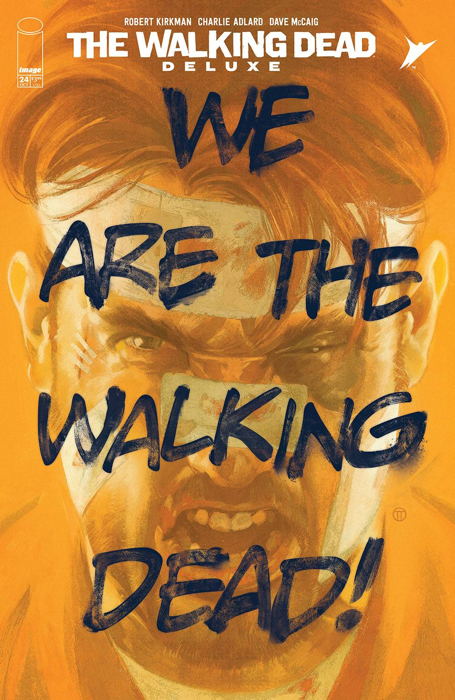
What’s great about this newest issue of Walking Dead‘s color reprints is how they just lean into the somewhat notorious “we ARE the Walking Dead!” declaration Rick makes in the issue. All but one of the variant covers features the phrase itself or a paraphrasing thereof, giving a hearty “take that, haters” to everyone who razzed the…on-the-noseness of it all.
I don’t know how the actual regular readers of The Walking Dead responded to the issue at the time. The color reprints also include the original letter columns, so I suppose I’ll find out myself in a month or two. My guess is that the fans invested in the book found it profound, while the comicsblogosphere of late 2005 probably happily snarked away at it out of its regular context. And while I don’t think I commented on it then, I would occasionally reference it for a gag, such as this recent tweet.
I’m pretty sure I’ve noted before that I am now reading The Walking Dead in its color reprint form, as I missed out on the series the first time. I mean, sure, not like there wasn’t plenty of ways to catch up on the book, what with all the trade paperback/hardcover/omnibus options, but I never seemed to get around to it. And now that it’s coming out in single issue form again every fortnight or so, it’s easy for me to just grab ‘n’ read them as they arrive.
Aaaaaaand…even in context, after having read issues #1 through #23, the “WE ARE THE WALKING DEAD!” exclamation at the end of #24 still comes across as perhaps just a tad overwrought. Too much Cochrane in First Contact saying “you’re all astronauts on some kind of star trek?” level of forced, dragging what should be subtext into just straight up text. On the other hand, if I wanted subtlety, I suppose I wouldn’t be reading a comic book called “The Walking Dead.”
All that said, it does come at the end of an effective extended speech from Rick, marking a turning point for our characters in this series. It’s essentially Rick emphasizing over and over that the old world, the old ways of doing things, are over, that everything you were used to is gone, and that they were going to have to get accustomed to doing things that were previously unthinkable in order to stay alive…not that “living” really means much of anything anymore. It’s bleak, it’s hopeless, and yet you still kinda want to see where things go from here, which was probably a hard trick to pull off.
Then there’s the two-page spread of Rick capping everything off with…well, you know, and I guess if you’re determined to get the title of the comic into the actual story somewhere, this is as good a way as any. Like I said, still a bit hokey, but, you know, what the hell, worse things happen at sea.
Also, if you’re wondering, of the many variants, the one pictured above is what I picked for myself, because it made me laugh.
• • •
A brief retailing update: I received my first order of Marvel periodicals from Penguin Random House this week. For me, anyway, it was a fairly auspicious debut, as everything I was expecting was actually in the boxes, which was a nice change of pace. There
were damages, with four comics having some pretty badly dinged corners, but I couldn’t tell if it happened in transit, during the packing process, or maybe they just came that way from the printers, who knew?
Now, I think I may have been lucky, as the boxes used to ship the comics didn’t seem to be as sturdy, or as sizable, as they needed to be to safely transport comics. The boxes were small, just barely large enough to surround the comics, and honestly one big bump along the way on a conveyor belt in the sorting plant, or being bounced aaround on the delivery truck, could have easily damaged whatever was inside. However, each box was packed with instructions on how to report any shortages or damages, and also had an actual packing slip with the name of the person who did that packing — certainly not anything I was used to.
By contrast, the regular distributor’s shipment…shorted me entirely on a Star Wars comic, shorted me about 1/6th my order of one of the new Bad Idea comics, and had a few plainly avoidable damages. You’d think having fewer books to sort and pack would cut down on that sort of thing, but, well, habits die hard I guess.
The shipment from my DC Comics distributor was exemplary as usual, though I keep hearing tales of other stores having immense problems with them. Maybe I’ve just been lucky so far. Once I had all my copies of one title not get packed, and there’s been the very rare single copy damage or shortage, but 99% of the time, the shipment is flawless. It’s nice to not have to worry about at least one distributor…I mean, not yet.
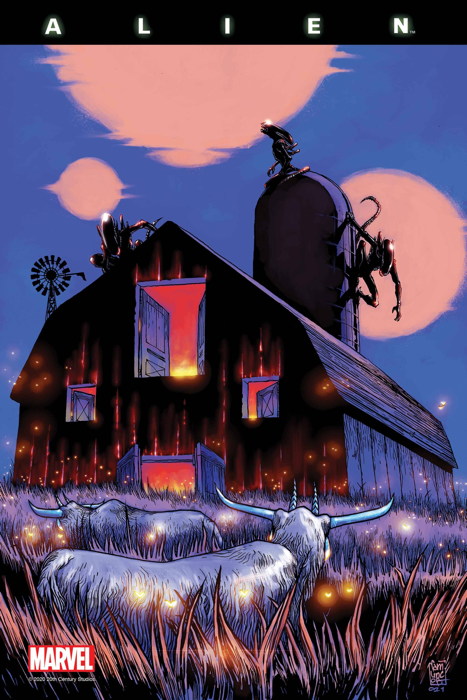
First, let me say I really have been enjoying this new Marvel era of the Alien comics, after not having read a whole lot of comics based on this franchise for the better part of…what, twenty years now? Has it really been that long? That’s not a judgement on the quality of the Alien comics that had come before…I’d simply had my fill and gave decided to give it a rest.
It seems like there are only two types of Alien story: people gotta get their hands on Aliens and things go badly, or Aliens suddenly show up where people don’t want them and things go badly. Oh, and the third type, “fighting Predators/Batman/Superman/etc.” And maybe a fourth type, “weird-ass story written by Jim Woodring.” And several stories, including the very first movie, are mixes of the two. In general, though, tales tend to lean one way or the other between those first two possibilities.
The first story arc was more “people want to get Aliens,” and with issue #7 and its new story arc, we’ve swung over to the other side and we’re getting “Aliens show up and distress ensues.” Which is perfectly fine, given we’re invested in the characters involved and the circumstances in the Aliens find themselves. The trick of course is making these things just as, if not more, interesting than the Aliens themselves.
I realize that’s very much a “your mileage may vary” sort of situation, in that perhaps not everyone finds the Aliens as interesting as I do…I mean, I could read a comic that’s just, like “A Day in the Life of the Aliens” that show ’em building nests, carrying eggs around, salivating, that sort of thing. But, you know, this is an Alien comic, and if you’re picking it up I’m presuming Aliens have at least some appeal to you, and you’re not just reading it for, I don’t know, romance between the lead human characters or anything.
This new story arc is off to a good start, with an infested ship crashing into a colony that’s just on the verge of independence from Earth, with a lead human character who’s put off having her terminal illness treated to ensure the colony’s survival. By which I mean contractual survival, not survival of an Alien attack, but I imagine we’ll be seeing more of that next issue. Anyway, she’s introduced as a strong and relatively deep personality, which will make for a good POV for the Alien fun to follow.
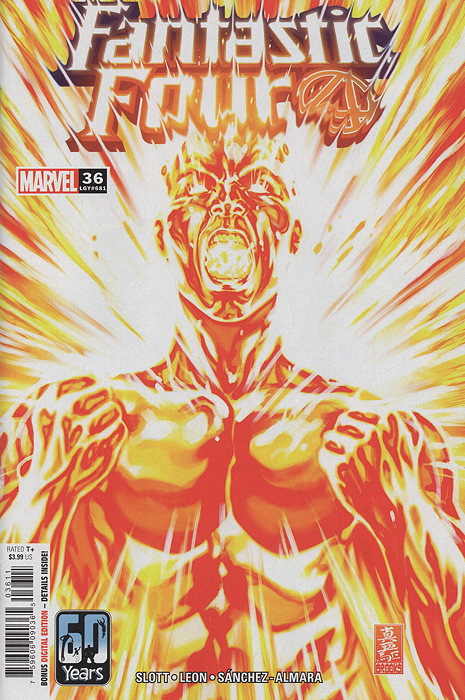
It’s only been a week since the last issue, which is a littly annoying from a retailing point of view, but from a comic-reading fanboy POV, it’s good timing as I’m really enjoying this “Johnny stuck flamed-on all the time” storyline. What I’m enjoying is how much story is put into each issue…still not a patch on how much Lee & Kirby would cram into their pages way back when. But still it feels like a lot of stuff is happening, and we’re getting plenty of new and weird situations, which is what I want from an FF book.
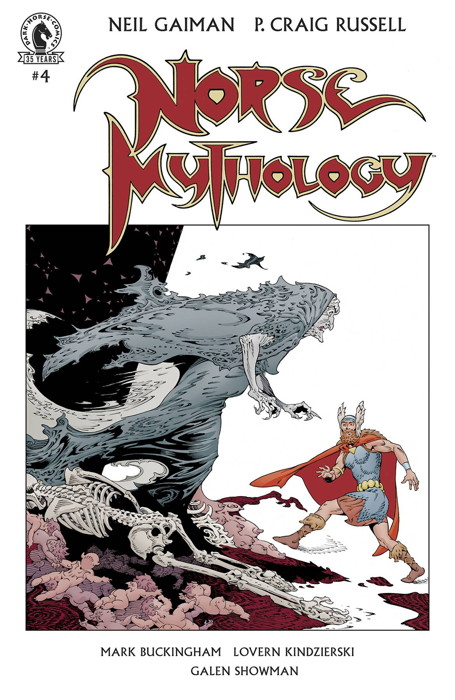
A long time ago, when I was but a wee Mikester, I had a book that contained a whole lot of Norse myths. One of the stories that stuck with me into adulthood was where Thor ‘n’ pals encounter the Giants and then are tasked with multiple challenges that they should be able to take on easily but are handed humiliating defeats. The secret behind how the Giants won these victories has amused me for decades, and how here it is in illustrated form. Not much to say here except “glad to finally see it.”
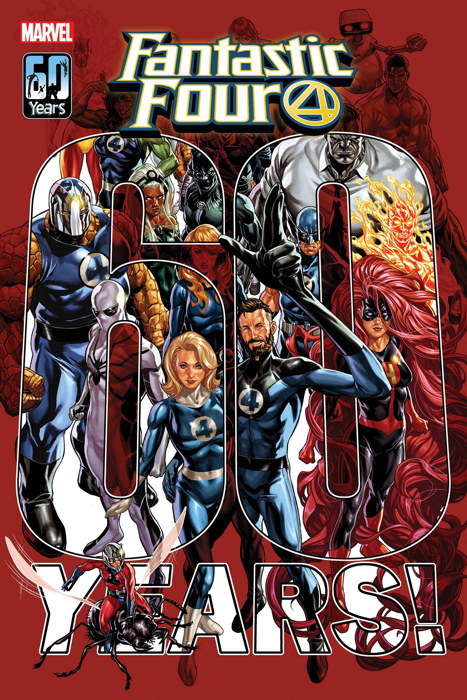
This issue of Marel Two-in-One was the first Fantastic Four-related comic I remember reading. Sometime after that I remember looking at some random issue of Fantastic Four my cousin had, which one I can’t remember, but I do know it was in the middle of some ongoing story and it was weird and strangely fascinating to someone mostly used to DCs and the occasional Charlton.
It wasn’t until the early ’80s that I began my full-on dive in Marvel Comics readin’, and my gateway was…an issue of The Thing, which brought me to John Byrne’s run on Fantastic Four (starting with the then-current issue and picking up the previous ones as I could) and then on to just about everything else Marvel-ish.
Fantastic Four, though, was one of the main two I stuck with (the other being Incredible Hulk and all its later permutations). I would occasionally not follow the title (there’s a big chunk of ’90s FF I skipped) but I have all those Byrne issues, the Waid run, the Millar run (which I still think is actually pretty good), Fraction and Hickman, Simonson, and now Slott…all readable, enjoyable and imaginative. I’ve also since read all the original Lee/Kirby stuff, with all its primal energy, laying the foundation for a fictional universe that is essentially dominating all popular culture today (even if its mostly been without the FF’s direct interaction, though not for lack of trying a couple of times).
None of this really says anything about the comic, so let me just say it’s a fun tribute to the team’s long history, with cute “chapter break” images that really drive home the time the team has spanned. You will not be surprised at all by one of the story’s “twists,” but really, it’s a wild trip though the FF’s history and that’s entertainment enough. It’s mostly a standalone book (though one major subplot does carry through from the previous issues, but the exposition train pulls into the station long enough to catch you up) so if you haven’t read FF in a while, it’s a good sampler of the title’s current status, and worth checking out.
• • •
On a copmpletely different topic, I was looking at my old Flaming Carrot action figure the other day. It has a feature where if you twist the little plastic plume of “flame” that sticks out of the top of his head, it will light up. Or would light up if the battery wasn’t long dead, I thought as I twisted the doodad, but lo and behold:
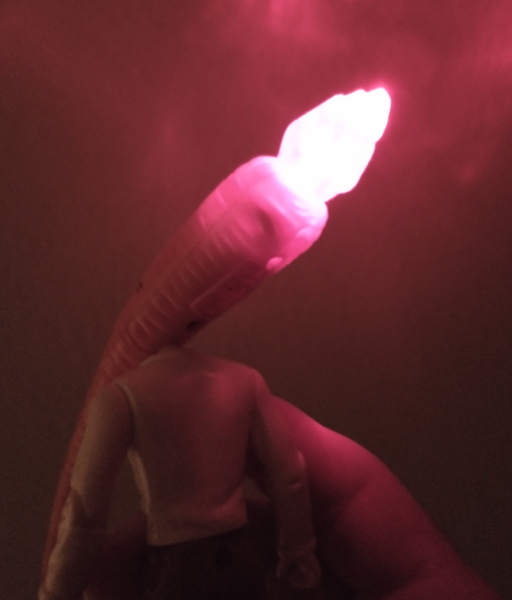
…LET THERE BE CARROT LIGHT. I wondered just how old this figure was, as I couldn’t recall exactly when I picked it up from the previous place of employment. A peek into Diamond’s database revealed 1) it was still listed in said database, and 2) it came out in December of 1998. Nearly 23 years later, that little light is still working. Amazing. Now if we can only fnd out what the Carrot’s actual secret identity really is, and where that speaker in his chest came from.
The official Dark Horse Comics site still has a page devoted to the figure (which gives a release day of November ’98). A closer look is in this pic I “borrowed” from an online source:
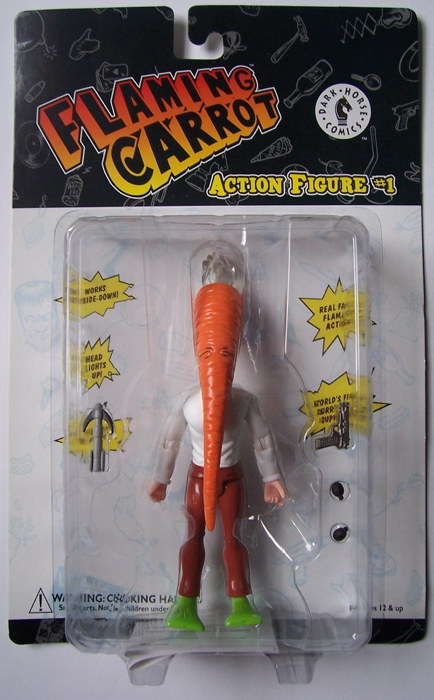
All that does is make me wish I hadn’t discarded the packaging for my figure.
[SPOILERS AHOY]
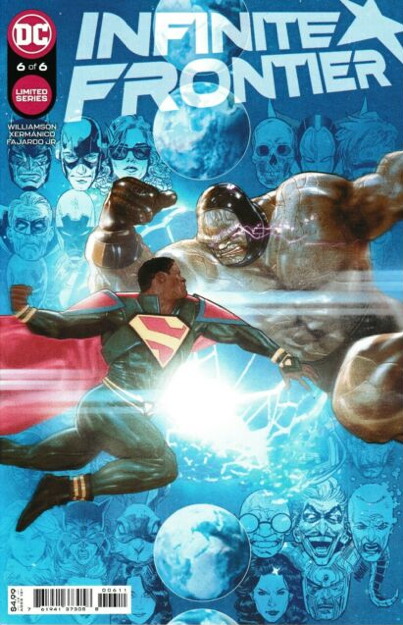
What this reminded me of, when all was said and done, was the Legends series DC published back in the mid-1980s, where the ultimate result of the series was to introduce the new Justice League (to some measure of success), or even DC’s Millennium, published a little later that decade, where the endgame was to introduce the New Guardians (to slightly lesser success).
Which, you know, is fine. That’s the goal of every comic book crossover…to get you to buy more comic books. They do it either by trying to turn you on to characters you didn’t normally read but were exposed to in the event, or they spin off new titles from the event that they hope you’ll be intrigued enough to sample. In this case it’s Justice League Incarnate, a team comprised of superheroes from across the multiverse, attempting to prevent Darkseid from breaking into the Omniverse and bothering Mark Gruenwald, presumably. And a handy footnote in Infinite Frontier directs you to said series, Coming Soon to a Newsdealer Near You.
Again, this is all fine. It’s just how comics are. And I like the idea of Justice League Incarnate and think the idea of jumping around the multiverse sounds like fun. But…DC’s spent the better part of three decades trying to roll back Crisis on Infinite Earths after realizing that maybe putting a whole bunch of restrictions on a world of imaginative fantasy was perhaps not a great publishing strategy. I enjoyed at the time the weird frisson of Crisis, where for perhaps the one time in superhero comics history you really did have the feeling that perhaps nothing and nobody was safe. But the price we paid was DC putting out an event series every once in a while that tried to get those worms all back in the tin, or at least get those worms to line up neatly and consistently so they could say “this is how things work now, for sure this time.”
The result is a pastiche of a memory of a time that the creators responsible are likely not even old enough to have experienced firsthand. All the terms and ideas are there, the Earths with numerial designations, all that jazz, but it doesn’t feel quite the same. This is a Me Problem, not perhaps a Those of You Who Are Younger Than Me Problem, as I did experience the old DC Multiverse firsthand in the funnybooks I got off the newsstands and I compare my memories of what was to whatever attempts are going on now to recreate it, and…I’m just gonna have to tear down that nostalgia wall in my brain and get used to what’s happening now, because unless Marv Wolfman steps in and knocks the entirely of DC continuity back to the 1980s, “nothing will ever be the same,” to borrow a phrase.
Anyway, Infinite Frontier #6 also promises the return of an old friend in 2022, so okay, they got me on the hook with that. Jerks.
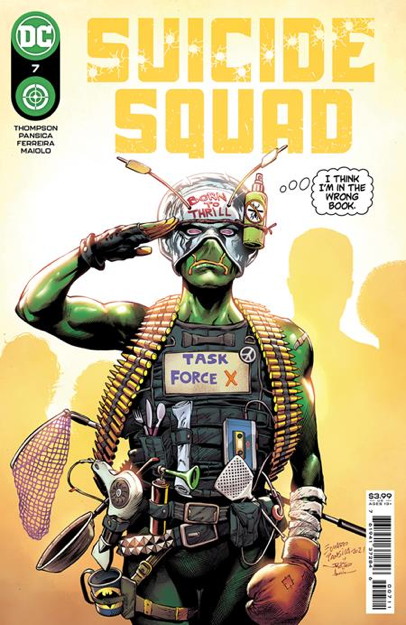
The return of Ambush Bug to whatever passes as mainline DC continuity, in what I presume is a small attempt at Deadpool-izing him by having a fourth-wall aware hero interacting with what would generally be considered a straightforward superhero adventure book. Of course, my awareness of Deadpool comes mostly from the movies and his appearances in one of the Marvel Lego video games, having only read one actual Deadpool comic in my lifetime, so I could be misunderstanding something here. Also, I though Harley Quinn and DC’s Deadpool, a character not necessarily bound by whatever demands are put upon stories by current continuity.
Anyway, Ambush Bug beat ’em all to the punch, being set aside from the regular DCU to do his own metacommentary thing (despite being introduced in regular continuity as, well, a murderer, and making the occasional appearance there, like this oddball thing). He retains his awareness that he’s a comic book character for Suicide Squad, which is treated by the other characters as being a sign that his bean is off-kilter…except he repeatedly demonstrates (at least for the reader) that he is correctly aware of his comic book existence. We’re in late 1980s Animal Man territory here, my friends…maybe he can team up with Grant Morrison.
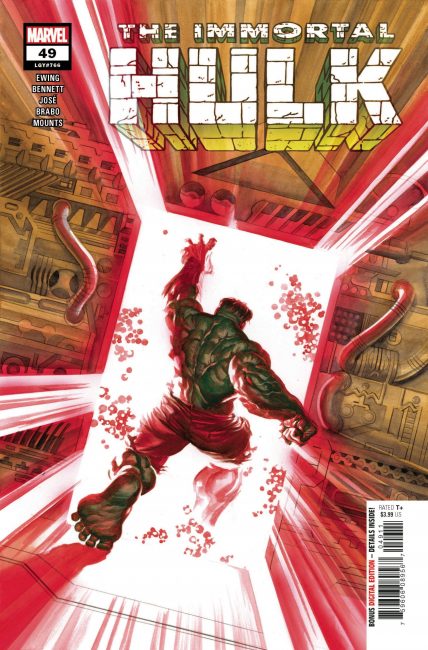
It’s a Special Album Issue, just like the good old days! Full-page illustrations combined with prose appearing in your otherwise regular Marvel funnybook…not a thing I’d like to see on a regular basis, but okay once in a while, especially if done well, like it is here, taking what could have been yet another Hulk-versus-heroes battle and applying some of the book’s usual levels of gravitas. One thing I liked is the opening (and continuing) comparisions between Bruce Banner and the Hulk with the Fantastic Four.
In an interesting confluence of events, Adam Warren, in his notes to Tuesday’s serialized page of Empowered, says
“…This does seem to represent a bit of a lost opportunity for superhero storytelling—that is, conveying how BLUDGEONING AND EARPIERCINGLY G-D LOUD that most cape-related conflict would be. Of course, the use of giant frickin’ sound FX and the like would burn up pagecount in a hurry, but this still seems like a narrative avenue worth exploring on occasion….”
And this issue of Immortal Hulk does just that, emphasizing the sounds of conflict, the drowned-out voices, et cetera…and given the illustrated text format of the issue, it manages to get around the sound effects problem that Warren posited. Thought that was a nice coincidence!
• • •
Joe
mentions, like I probably should have in Monday’s post, that the double-covered #2s had been a prominent feature during the “Heroes Reborn” year-long experiment with the Image Comics artists. Not just on the Reborn books, but on new title launches like
Thunderbolts (which I remembered) and he also mentions
Deadpool, which I didn’t remember and can’t find that it had a second cover (beyond having a newsstand “variant” with the standard UPC…am I missing something? Wouldn’t surprise me! ). Anyway, I should have noted when the two covers for the second issue started, and thank you Joe for stepping in.
Matthew asks
“Years ago I remember reading that for some period of time the second issue of the GI Joe series that Marvel put out was actually more valuable than the first issue because there were so many fewer issues printed. Was that ever true? Is it still true?”
Other commenters provided their answers, but I thought I’d answer here, too. Yes, there was a time when the second issue of Marvel’s G.I. Joe: A Real American Hero was commanding higher prices than the first.
Now I’m just working off my memories instead of, you know, doing research, but I believe the common belief was, true or not, that the second issue had a smaller print run that the first. And given that G.I. Joe was a relatively popular commodity at the time, it wouldn’t surprise me to find out that the first issue was in higher demand than expected, and retailers lowering the order on the second issue (without yet knowing how #1 would be received) resulted in the higher demand and comparative scarcity.
Contributing to this disparity in cover prices. Issue #1 was extra-sized and printed on nicer paper, selling at $1.50:
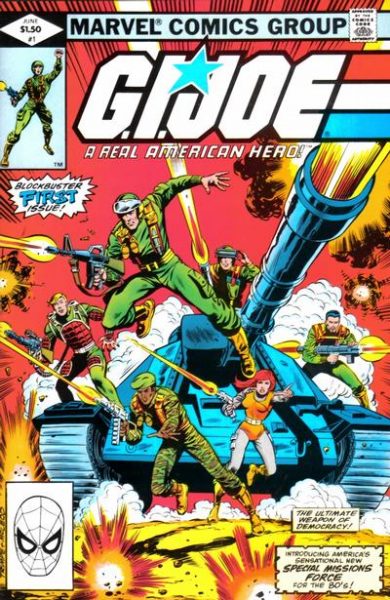
…and then #2 was the standard format comic at 60 cents:
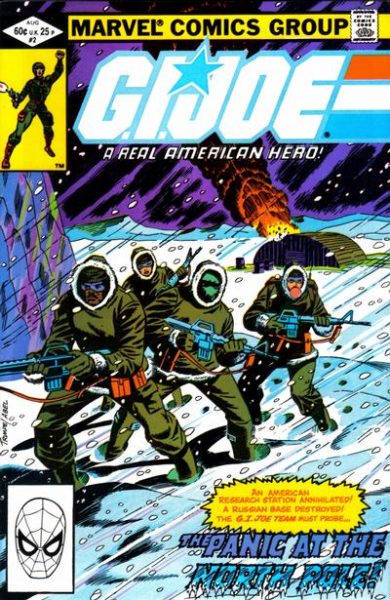
If I had to hazard a guess, backed up by literally no evidence whatsoever (though maybe I can peek through my fanzines from the period and see what sales on these were actually like) beyond my own proclivities as a comics retailer…I’d say that $1.50 price tag on a cartoon ‘n’ toy tie-in, two and half times the price of a standard comic, may have kept orders lower on the first issue. I mean, no matter how popular the property may have been at the time, there was no guarantee that would translate to comic sales of any note, and that high a price tag might have made the buying decision for anyone on the fence about it. And with that seeming barrier to entry, there was no reason to expect much repeat business for the second issue, even at the lower price.
Now please note that at no time am I saying the comic wouldn’t have had strong orders, or that it didn’t…just that the cover price may have kept them from being even stronger. And as it turned out, the first issue was very popular, enough so that there wasn’t enough of the second issue to go around, therefore low supply + high demand = $$$ for somebody. As a result, the price guide regularly had #2 listed at a higher price than #1.
But enough time has passed, with most early G.I. Joes being in less reliable availability at your local comics emporium, that the whole “lower print run” thing, if it ever actually was a thing, is of negligible importance in today’s market. #1 and #2 are both equally difficult to come across, and with the back issue market becoming increasingly focused on “number ones” and “key issues,” it’s not much of a surprise that prices for that first G.I. Joe have zipped on past those for the second.
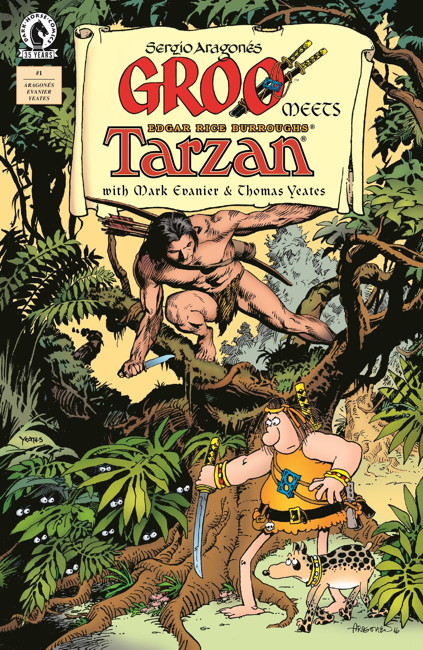
Groo Meets Tarzan is a “crossover” in the same way that Groo Versus Conan mini from a few years back was — a fourth-wall breaking story in which the creators of Groo are the framing device for the book’s events. It’s a strange gimmick in which the adventures are explicitly presented as fictional constructs…I mean, yes, obviously, we know they are, but having two different stories with essentially the same hook relatively close to each other in this decades-long progression of Groo stories is…
“Mike, it’s just a comic book, mellow out dude.”
Yeah, okay. I believe Mr. Evanier said on his site that this will likely be the last of these crossovers with the large-nosed wanderer, and that’s probably fine. The melding of two very different styles of characters is too…”world-breaking” for Groo’s milieu except when presented, as they have been in the Tarzan and Conan events, within the narrative itself as “What Ifs” or “Imaginary Stories” or whatever other copyrighted term I can borrow from Marvel or DC. Because, obviously, as Evanier has said in the past, anyone with whom Groo crosses over would obviously be dead in short order if it “really” happened, and I suspect the various licensees involved would not be too pleased.
It is nice to have Groo back after too long a hiatus, partially due to the COVID-related delays. And the comic is funny, including a nice two-page Mad Magazine-esque crowd scene taking place at the San Diego Comic Con (where Mark and Sergio are present to talk about their Groo Meets Conan comic, drawn as only Mr. Aragones can do it. Detail for days in that spread. Groo and Tarzan are on their own separate threads in this first issue, with Tarzan looking for slave runners in his story, and Groo inadvertently menacing a couple of villages in the other, and you keep waiting for the two to collide. Alas, how do you keep a Groo fan in suspense? We’ll tell you next issue!
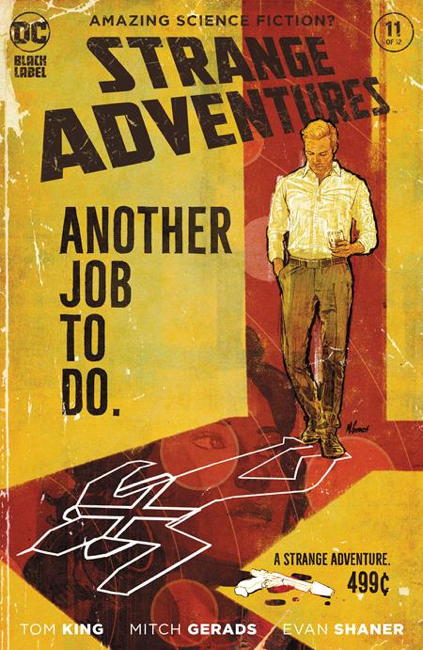
I get the feeling Strange Adventures will read better in collected form, or at least with all the issues in front of you to read in short order. I mean, the events of the plot itself are fairly straightforward, but many of the emotional ups and downs and the rationales of the characters involved can be hard to track issue to issue, particularly when they have a little extra time between releases. I mean, I’m not sure I like Adam Strange much in this story, which is certainly the intent. And some of Alanna’s reactions to Adam emphasize her “alien-ness” — I mean, yes, she’s basically human, but some of her comments about humans and Earth remind you that Adam totally married an extraterrestrial.
It’s a hard read, the fight between Adam and Alanna, but not hard in a bad way. It’s fascinating, it’s involving, and you keep waiting for a way out of this mess to show itself and hoo boy it does not. Only one issue to go, and while I’m usually of the opinion that drastic choices made with characters usually get undone or reduced so that other creators can play with the toys…I’m honestly wondering how this is going to end. And which comic creator’s quote will be on the last page…that’s been a fun bonus. May I suggest “It’s all just lines on paper, folks!” from a Mr. R. Crumb?
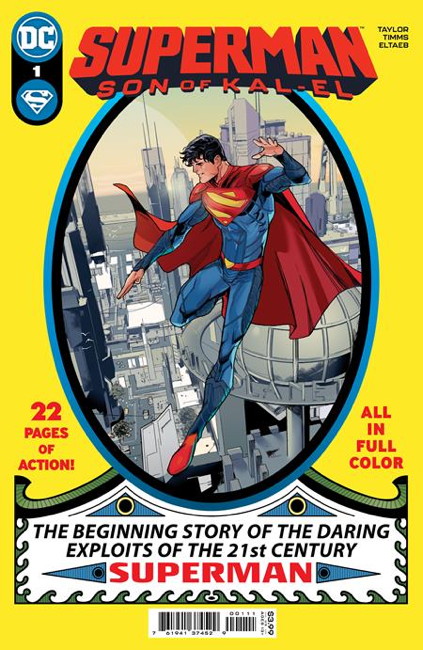
I honestly thought by this time DC’s usual rebootery/universe-rejiggering shenanigans would have done away with the biological sons of Batman and Superman, but here we are, years later, and they’re still hanging around as integral parts of their respective franchises. Damian Wayne feels like a more natural fit, a new somewhat adversarial Robin to his pops Batman. Jon, the son of Lois and Clark, seems a little less so, especially after the plot mechinations of one story aged Jon into his late teens.
But this new series seems to be heading in a good direction, giving Jon his own purpose as well as a couple of good scenes showing that he’d learned the right things from Pa El. Plus, I’m a sucker for the repurposing of the original cover for Superman #1. What a classic image that is.
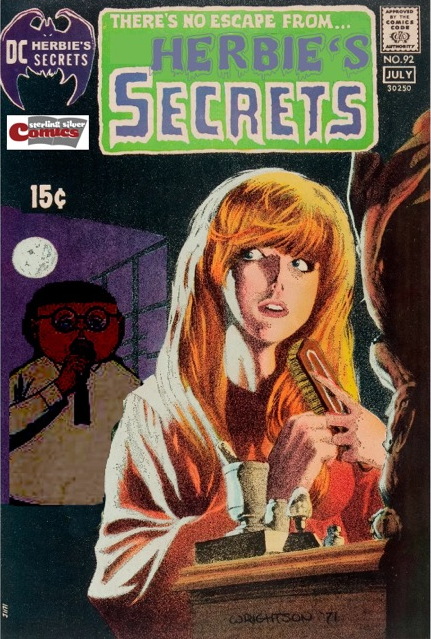
Thanks to reader/mad genius Paul for sending this mock-up of what could’ve been for a Sterling Silver Comics retailer exclusive variant!
Following up on my discussion about that very topic from Monday, I’d actually pulled up an email I received from A Comics Publisher in response to an inquiry I’d made along these lines. Without going into a whole lot of specific detail, let’s just say my buy-in, just for the minimum copy purchase of the exclusive variant, would have been in excess of $10,000. That doesn’t count other minimum orders for the regular cover or other variants of your retailer variant, or for paying for the actual artwork by the artist.
Basically, it’s a lotta scratch…not undoable, entirely, but certainly an investment that would require some first class hustling to make that cash back. Which could be a problem in case you got a cover that didn’t grab the attention of the sort of folks who look for exclusive variants like this. But, to be honest, the way the marketplace is right now, seems like anything that has any form of scarcity is automatically in demand.
Anyhoo, something to think about the next time the opportunity arises.
But speaking of “scarcity,” apparently the latest issue of Usagi Yojimbo, #20, is “in demand” due to it being a first appearance of a character whose name I bet most of the people looking for it couldn’t even tell you. My distributor decided, alas, that this would be one of the comics they’d be shorting from my order last week (there’s usually a few every shipment). I figured that would be that, given it’s temporary hotness and all spare copies eaten up by reorders, I’d have to wait for the second printings to come along so I can get copies for customers who actually want to read it. Somehow, though, miracle of miracles, my replacements showed up! I mean, sure, half my Fireflys are missing and several of my Marvel Voices: Pride shorted or damaged, so it’s always something.
As to the Marvel Voices: Pride comic, it surprised me a bit by including select pages from Alpha Flight #106 (1992). In case you forgot, that’s the comic where Northstar finally just straight up said, after years of subtle-ish hints, “yeah, I’m gay.” Which was, granted, a pretty big deal, and demand for the issue warranted a second printing. But this was also at the height of the whole “gotta be EXTREEEME” art thing, and…yeah, it certainly looks a bit jarring side-by-side with more current art styles. Hey, gotta start somewhere! (Also, did they ever bring back Major Mapleleaf from that story?) (Yes, I know that was a nickname of Alpha Flight’s Guardian at one point.)
I should also note that my comments sections here on Rogressive Pruin occasionally take on a life of their own. So, if you ever wanted to delve deep into the origin of the word/sound/expression “vootie,” well, your day has come.
So to add to my Superman: Birthright discussion on Monday, the writer of said book, Mark Waid himself, dropped on by to clarify/correct some of my assumptions. Primarily, that Birthright was indeed intended to be the new “official” Superman origin, but was eventually decided that yet another version, the Geoff Johns/Gary Frank Secret Origin mini, would be the new official origin instead. Least ’til, you know, they changed it again.
Anyway, here’s a period article with an interview with Mr. Waid about Birthright being the “official” origin, which was declared so late in the run due to the Super-books being “still somewhat in flux” when the series began. While I was correct in that the state of Superman’s history at that point was a bit mushy and open to revision, as I said in my last post, my assumption that Birthright was a planned out-of-continuity story that eventually ended up in continuity despite itself was incorrect.
So, when you reread that last post of mine, disregard my poor use of Birthright as an example for my thesis. I think my overall entry there is correct, in that if you leave any ambiguity to the canonicity of a story involving DC or Marvel characters in what appears to be their familiar milieus, the default position of a certain subset of fandom regarding that story is that it’s part of official continuity. And that the emphasis, especially by DC, on continually trying to establish what is their official continuity only encourages the behavior.
Not all fans do this, of course, but like I said, I’m still getting customers asking me if Three Jokers is, you know, Real Joker History and, well, what can you do. “It is if you want it to be!” I’ve answered more than once, and I don’t know if that helps, really.
Okay, let me say something about a couple of comics that came out this week:
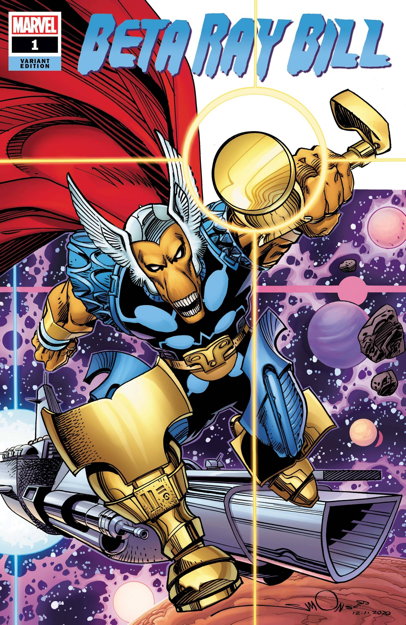
I didn’t keep the cover pictured above…this is one of those “retailer incentive variants” that I have to order a certain number of the regular covers in order to receive. But you think I’m gonna pass up posting a kickass Beta Ray Bill pic by his creator, Walt Simonson, on my site? Heck no.
Anyway, the entirety of my Thor reading is as follows: the Walt Simonson run from #337 to #382 (plus the couple of fill-in issues in that run, which were also great), whatever stories were in the Origins of Marvel Comics books, and the Lee/Kirby “Search for Galactus” issues that pal Cully let me borrow once. Nothing against Thor, and I know some later runs of Thor are very highly regarded, but my brain decided “That’s All The Thor I Need” and that was that, I guess.
When I opened my own shop a few years ago, I gave up my Thors (not Cully’s Thors, I returned ’em, honest) to the back issue bins, which was a good idea because boy did they sell well. As they should, because they’re beautiful and perfect, but “Fanboy Mike” is a tad annoyed at “Retailer Mike” as I kind of miss having those. But hey, I figured at the time I could always pick ’em up in reprints one way or another.
So basically I haven’t been involved in Thor comics for a while. Then why pick up Beta Ray Bill #1? Well, the work of Daniel Warren Johnson for one, who is writing and drawing this book and it looks fantastic. I’m not one for two-page spreads in comics nowaways, but Mr. Johnson throws in a couple of them in this issue and I know I really like a comic when that doesn’t bug me in the slightest. It all feels like a natural extension of Simonson’s rendition of the character without being an imitation of his style, in a way that previous efforts with the Beta Ray Bill have not.
As someone who, as I just told you, hasn’t been immersed in recent Thor comic shenanigans, there wasn’t a steep learning curve for getting caught up to speed on recent Asgardian events. Johnson does a good job naturally slipping in the necessary exposition to establish the world of the book and the premise for the series.
Yes, it is, nominally, a tie-in to the “King in Black” event currently happened at Marvel, but it barely counts, a “Red Skies” type of crossover where a Surprise Guest Monster shows up to wreak havoc in Asgard and oh, he’s all King in BLack-ized or whatever they call it. Could easily just have been Special Surprise Guest Monster all on his lonesome and the effect on the plot wouldn’t have been any different, really. But if it gets more eyeballs on the comic, then we shall let this pious fraud pass.
What I’m saying is that Beta Ray Bill is just as good as I’d hoped it would be, since seeing preview pages a while back. As someone actively not looking to pick up new series right now due to my immense funnybook backlog caused by eyeball issues, I snatched this one up with no regrets.
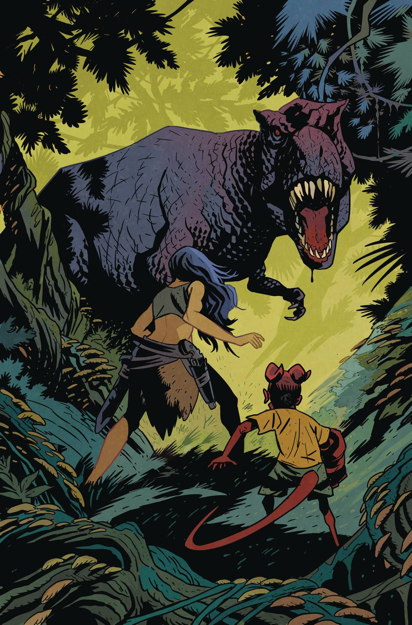
Young Hellboy is a fun, cute series, the second issue of which is out this week. Young Hellboy runs into a Golden Age-style jungle girl on a mysterious island, and seeing HB as an overly talkative, hyperactive child is always entertaining. With the forward motion on the “current” Hellboy timeline effectively ended with, um, the end of the world, it’s nice that we’re still getting “flashback” Hellboy stories. “Hellboy may be dead but his cash flow lives on,” as the Dead Milkmen said (slightly paraphrased). Even knowing the eventual end point for the Hellboy Universe, the sense of impending doom doesn’t weigh too heavily upon these stories…I mean, not that particular doom, anyway.
It’s a nice reminder of what Hellboy was, back before the plot overtook the premise and everything was pointing to The End, versus just the big red guy smacking monsters around and shooting (badly) at demonic foes. Or, as in this series, swinging on a vine and shouting with glee. As I said, fun and cute.
So let’s celebrate this Friday with the fact that Superman (pictured here)
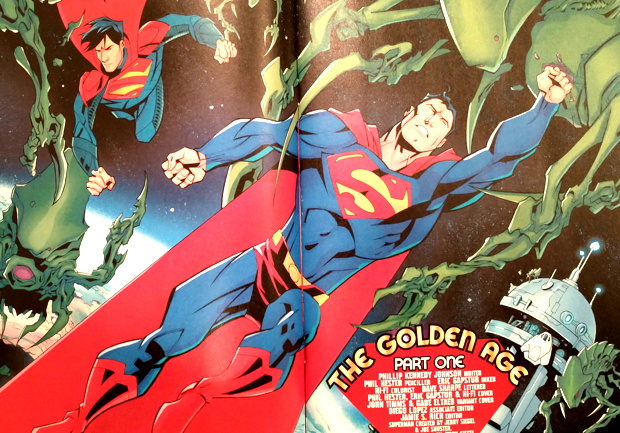
…doesn’t have those cuff-rings or whatever at the end of his sleeves.
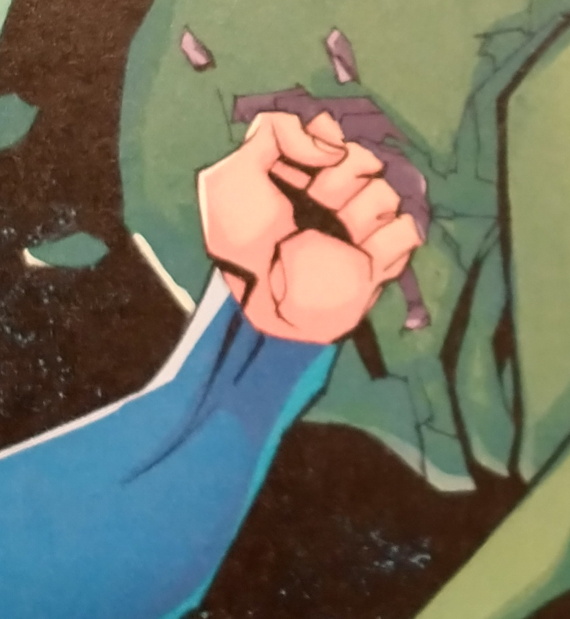
Those little cuffs were the last vestiges of Jim Lee’s awful redesign of the Superman costume for the New 52 relaunch nearly ten years ago, which I presume were held onto stubbornly by DC editorial as they reverted all the other changes wrought upon the superclothes. I wrote about the problems with the costume here, and I hope it gets across the idea that it wasn’t a purely reactionary response to this new outfit in a “we fear change” Garth-from-Wayne’s-World sort of way. There were genuine messaging and conceptual issues with the costume, as well as basic aesthetic ones, as to why the redesign was so roundly rejected.
Anyway, if the cuffs come back next issue (or in Action, ignore this post. …And the comic itself felt like a reverting of tone to the pre-Brian Michael Bendis era. I do have to say every time I see Lois ‘n’ Clark’s super-son Jon Kent, there’s always the tickle in the back of my mind “so when are they going to decide to get rid of him?” Not because I dislike the character, but because his presence feels like a bending of the Superman premise perhaps just a tad too far, and sooner or later someone at DC (or someone in the Warner Bros. organization higher up than anyone at DC) is going to ask that everything in the franchise be changed back to how it was.
Or, you know, just have it all ended entirely and the Superman family of characters are handed over to the toy division for proper exploitation. Either or.
[SPOILERS ahead, mostly for Generations: Forged]
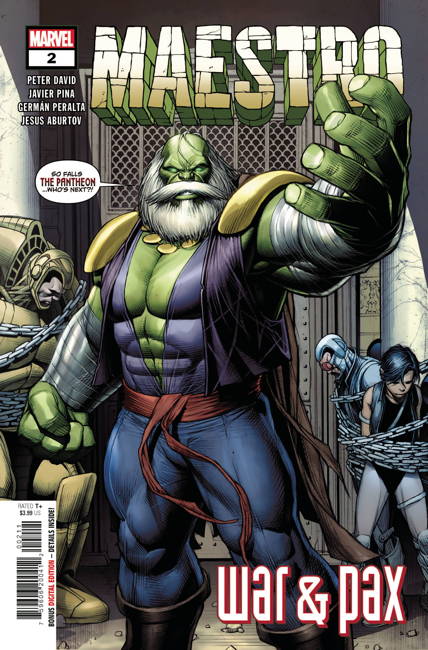
So this story (detailing the rise to power of the Hulk as “The Maestro,” ruler of a future post-apocalyptic Earth as detailed in the Future Imperfect mini-series) involves The Pantheon, a superpowered team allied with ol’ Jade Jaws back around the early ’90s. That Future Imperfect comic I mentioned paranthetically also dates to the early 1990s. Now, I bought those comics new, so I certainly remember the stories and the characters, despite being (urgh) nearly 30 years ago, but it surprises me just a little that a follow-up being published now is doing as well as it is.
Now I say only a “little” surprised if only because 30-year-old comic stories aren’t necessarily as hard to get your hands on as they used to be. Marvel’s trade/hardcover program, even as haphazard as it is, has managed to keep writer Peter David’s work on the Hulk relatively available, including the issues involving both the Pantheon and most of the Maestro stuff. And that now thrice-noted Future Imperfect series has been reprinted plenty of times, including a relatively cheap one-shot released around the time the first Maestro mini was released last year. Oh, did I not mention that the Maestro pictured above is in fact the second issue of the second Maestro series, since the first one did so well?
In addition to physical reprints, I’m reasonably sure (even though I don’t personally have the service) that the relevant issues are all available on Marvel’s digital comics subscription service. So, you know, fans can catch up there too if they missed all that stuff the first time, because “I wasn’t born yet” or whatever lame excuse these young punks have.
The Maestro himself has popped up now and again in Marvel’s books, including a revisit by David to the character in later issues of Incredible Hulk, there was a tie-in mini to Secret Wars in 2015, I’m pretty sure the character’s popped up in a video game or two…basically, he’s been part of the landscape.
Now the Pantheon, those folks have been missing from comics for a while, so I wonder how many folks had to scramble to the Wikipedia page to find out who they are? Or how many readers just took it in stride, getting enough backstory they needed from these new comics by themselves, and were fine? I’m always curious about that sort of thing. I’ll read new comics and think “I’ve been reading comics for over 45 years, I know what’s going on, but can new readers catch on?” Seems like jumping in and hanging on to the latest issue of a funnybook was easier to do back in ye olden tymes of my youth. But also in my youth I didn’t have the variety of resources to inform me as to what I missed as people do now.
Anyway, just thought that was interesting enough to blab about it on my site for a few hundred words. …Oh, was the comic any good? Yeah, sure, David does a good job fitting it all in with his other Hulk work, and it all feels of a piece. Makes one sorry he ever had to leave the book in the first place (and second place, when he came back for a year), as he clearly had more stuff to say about the character. But then, we wouldn’t have had the other nice work occasionally done on the character since then, so I guess it all works out.
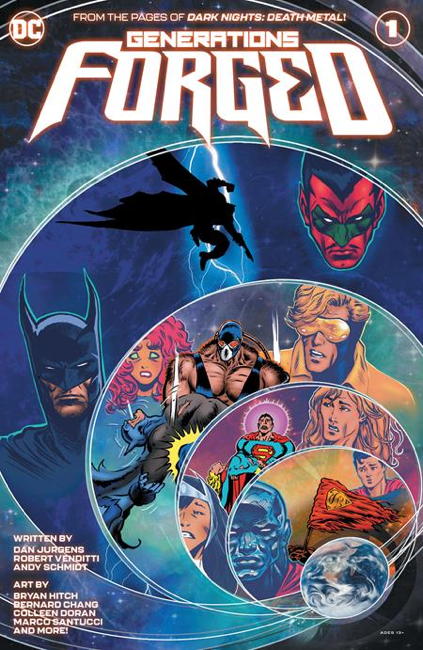
So, Generations: Forged. [REMINDER: spoilers.]
First, so the ultimate goal of Generations was to do the same thing to Batman that the mostly forgotten Doomsday Clock attempted to do with Superman…establish that the character has existed for decades in this universe, and that he continually gets updated/rebooted/refurbished/whatever as the universe undoes its regular restarts. Or, you know, something like that. I guess having Superman be established as essentially the center of the universe wasn’t enough, they had to make sure Batman was along for the ride…when Superman and the universe are rebooted, so is Bats, and I guess presumably everyone else they’re in contact with. I think I’m understanding that ending properly.
Second, if, as the recent Death Metal mini established (and Generations ballyhoos itself as being “from the pages of…” that series, the connection’s there) that all the characters remember all their histories across the reboots, then I presume Batman can draw a straight line from being that guy with the cockeyed Bat-ears in the 1930s to fighting Clownhunter today. And also teaming up with Scooby Doo, I refuse to disallow that from continuity.
Third, for being the “big event” we were promised for a long time back when Dan DiDio was still at DC, it seemed…like not enough, really. I know plans were curtailed somewhat, but I swore there was going to be more after this second installment and it looks like just a hardcover collecting the two issues (and the one story from Detective #1027) is all that’s coming.
Fourth, the idea that when Starfire flies, that’s literally a giant stream of hair flowing behind her, and not artistic license to show how fast she’s flying or anything, is bonkers. Did you look at New Teen Titans and think “boy that’s a lot of hair trailing behind her, like hundreds of feet worth” or did you figure George Perez was just using the imagery to dynamically and symbolically present her flying power. Because seriously, that it’s her hair is a plot point in this comic. Like, there’s a chunk of that long stream of hair left behind for other people to find. Anyway, that was my stupid reaction to the comic.
I did like the comic, in case you were wondering. As I said last time, this was the most Dan Jurgens-est of comics, which isn’t a bad thing. It’s comfortably familiar super-heroing, somehow evoking the crossover events of old while still incorporating the “universe redefining” aspects of the new events. And in retrospect, two extreeee-sized issues of this was probably enough.
• • •
I do plan on returning to the trading card pricing topic of
this post from Monday…that was going to require more time than I had for blogging this week (hence only the two posts) but I’m not done with it yet.
Thanks for reading, pals, and see you Monday.
« Older Entries
Newer Entries »




























